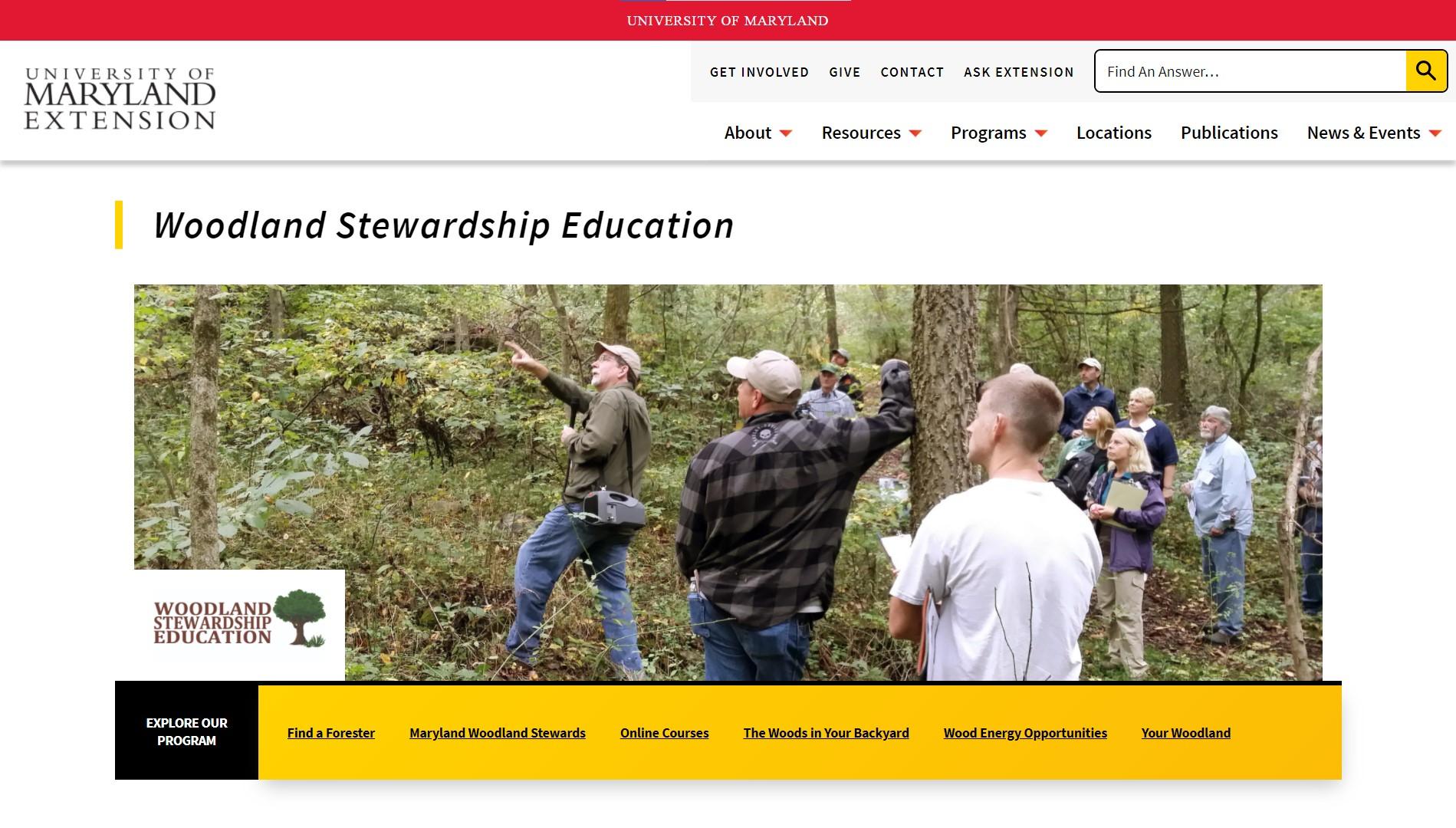After several years of planning, designing, testing, and developing, the new Woodland Stewardship Education (WSE) website went live in early April 2021. The successful rebranding of the site is part of a larger part of University of Maryland’s College of Agriculture and Natural Resources (AGNR) and University of Maryland Extension (UME) to create a more user-friendly interface.
The previous version of the WSE website premiered in 2013. At the time, it followed current trends for layout and design, and was designed to be viewed strictly on desktop or laptop screens. The proliferation of handheld devices, and the increasing preference of them by younger users of the World Wide Web as their preferred internet portal, has led webpage designers to create sites that are navigable no matter what size screen is being used. The 2013 version of AGNR’s, UME’s, and WSE’s sites did not pass these tests.
The contracted design firm held listening sessions with UME offices across the state in 2019, collecting input and feedback from users and content developers. In mid-2020, the AGNR communications team shared the framework of the new design, and asked UME content developers to thoroughly examine their existing content and create new “hierarchies,” or “outlines,” for their sites.
At WSE, Jonathan Kays and Andrew Kling decided that this would be an opportune moment to create a new hierarchy for the site in general and to update the website’s content. Once the hierarchy was approved by the communications team, it was time to develop content to fill it.
The effort, which lasted several months, was worth it. For example, in the new design, the program’s video and webinar recordings are easier to find. The forest stewardship information in the “Your Woodland” section contains new and updated content. And there’s improved navigation for property owners looking to hire forestry professionals.
UME’s improved features enable users to find Extension publications more efficiently. By creating a roster of keywords called “tags,” content users can ensure that their fact sheets, extension bulletins, or other publications are listed with others from across UME that have similar content.
For example, a search for “forest health” from any UME page will give you several options. “Forest Health in Forestry” will provide all the resources where the tag is used on our website, including recent (2019-2021) issues of Branching Out. If the phrase is used in a publication, that will also be listed. The final option will generate a list of all UME resources, publication and more that include that phrase, although that will include less specific results.
In the coming months, we will continue to develop the WSE pages to include some legacy content, such as selected back issues of Branching Out, and will incorporate user feedback to improve the site. We encourage you to explore the site and to let us know what you think!
Visit the new site at: go.umd.edu/woodland
 English
English العربية
العربية Български
Български 简体中文
简体中文 繁體中文
繁體中文 Hrvatski
Hrvatski Čeština
Čeština Dansk
Dansk Nederlands
Nederlands Suomi
Suomi Français
Français Deutsch
Deutsch Ελληνικά
Ελληνικά हिन्दी
हिन्दी Italiano
Italiano 日本語
日本語 한국어
한국어 Norsk bokmål
Norsk bokmål Polski
Polski Português
Português Română
Română Русский
Русский Español
Español Svenska
Svenska Català
Català Filipino
Filipino עִבְרִית
עִבְרִית Bahasa Indonesia
Bahasa Indonesia Latviešu valoda
Latviešu valoda Lietuvių kalba
Lietuvių kalba Српски језик
Српски језик Slovenčina
Slovenčina Slovenščina
Slovenščina Українська
Українська Tiếng Việt
Tiếng Việt Shqip
Shqip Eesti
Eesti Galego
Galego Magyar
Magyar Maltese
Maltese ไทย
ไทย Türkçe
Türkçe فارسی
فارسی Afrikaans
Afrikaans Bahasa Melayu
Bahasa Melayu Kiswahili
Kiswahili Gaeilge
Gaeilge Cymraeg
Cymraeg Беларуская мова
Беларуская мова Íslenska
Íslenska Македонски јазик
Македонски јазик יידיש
יידיש Հայերեն
Հայերեն Azərbaycan dili
Azərbaycan dili Euskara
Euskara ქართული
ქართული Kreyol ayisyen
Kreyol ayisyen اردو
اردو বাংলা
বাংলা Bosanski
Bosanski Cebuano
Cebuano Esperanto
Esperanto ગુજરાતી
ગુજરાતી Harshen Hausa
Harshen Hausa Hmong
Hmong Igbo
Igbo Basa Jawa
Basa Jawa ಕನ್ನಡ
ಕನ್ನಡ ភាសាខ្មែរ
ភាសាខ្មែរ ພາສາລາວ
ພາສາລາວ Latin
Latin Te Reo Māori
Te Reo Māori मराठी
मराठी Монгол
Монгол नेपाली
नेपाली ਪੰਜਾਬੀ
ਪੰਜਾਬੀ Afsoomaali
Afsoomaali தமிழ்
தமிழ் తెలుగు
తెలుగు Yorùbá
Yorùbá Zulu
Zulu ဗမာစာ
ဗမာစာ Chichewa
Chichewa Қазақ тілі
Қазақ тілі Malagasy
Malagasy മലയാളം
മലയാളം සිංහල
සිංහල Sesotho
Sesotho Basa Sunda
Basa Sunda Тоҷикӣ
Тоҷикӣ O‘zbekcha
O‘zbekcha አማርኛ
አማርኛ Corsu
Corsu Ōlelo Hawaiʻi
Ōlelo Hawaiʻi كوردی
كوردی Кыргызча
Кыргызча Lëtzebuergesch
Lëtzebuergesch پښتو
پښتو Samoan
Samoan Gàidhlig
Gàidhlig Shona
Shona سنڌي
سنڌي Frysk
Frysk isiXhosa
isiXhosa